New research from the ilSIRENTE study suggests that higher physical performance levels significantly correlate with increased survival rates in individuals over 80 years of age. The findings, published in the Journal of the American Geriatrics Society, provide compelling evidence that physical performance is a crucial predictor of longevity in the elderly.
Study Methodology
The study analyzed data from 195 participants, all born before 1924, who were part of the ilSIRENTE study—a prospective cohort study conducted in L’Aquila, Italy. The focus was on participants aged less than 85 years at the time of enrollment, with a mean age of 82 years. Physical performance was assessed using the Short Physical Performance Battery (SPPB), which evaluates balance, gait speed, and leg strength based on the ability to rise from a seated position in a chair.
Participants were classified into categories of severe, moderate, mild, or no functional impairment based on their SPPB scores.
Key Findings
One of the most striking findings was that approximately 21% of the participants lived to be 95 years old. The study revealed a clear link between higher SPPB scores and faster gait speeds with a reduced risk of mortality before reaching 95 years of age. Specifically, the average gait speed for participants who lived to 95 was 0.88 meters per second, compared to 0.78 meters per second for those who died earlier.
Practical Implications
“Physical performance is a reliable metric for assessing mortality risk in octogenarians,” the authors of the study stated. “Our findings, together with available evidence, support the view that physical performance is a primary target for interventions to enhance longevity and extend health span.”
These results underscore the importance of maintaining physical fitness in later life. Interventions aimed at improving balance, gait speed, and leg strength could potentially play a significant role in extending both lifespan and health span among the elderly.
Study Limitations and Disclosures
While the study offers valuable insights, it is limited to data from a specific older population in Italy, which may affect the generalizability of the findings to other populations. The research was supported by the European Commission and the Italian Ministry of Health, with no reported conflicts of interest among the authors.
Conclusion
This study highlights the crucial role of physical performance in predicting longevity among octogenarians. As the global population continues to age, these findings emphasize the need for targeted physical fitness interventions to improve the quality and duration of life for the elderly.
For more details, refer to the full study published on May 2, 2024, in the Journal of the American Geriatrics Society.












